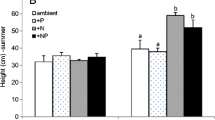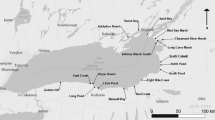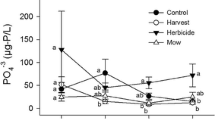Abstract
Invasive plant management is a key focus of wetland managers, and considerable resources have been devoted to control of non-native Phragmites australis in many Great Lakes coastal wetlands. This study examined short-term (1-year) impacts of herbicide management by comparing wetland plant productivity, nutrient availability, and plant communities before and after herbicide treatment in two coastal wetlands. We also monitored a third wetland in years 3–5 following herbicide treatment. After herbicide treatment, annual aboveground net primary production and plant nitrogen and phosphorus uptake decreased dramatically (by an average of 88%, 80% and 89% respectively; p < 0.05); porewater soluble reactive phosphorus (SRP) and surface water ammonium increased at one site (p < 0.05), while porewater ammonium increased at the other site (p < 0.05); porewater dissolved organic carbon concentrations increased at both sites (p < 0.05); and porewater nitrate did not change at either site. Despite large reductions in Phragmites biomass following herbicide treatment, floristic quality did not improve. When scaled to the area surrounding Lake Erie’s Western Basin treated with herbicide in 2012, the reduction in plant nutrient uptake accounted for 24 × 103 kg of phosphorus and 159 × 103 kg of nitrogen, nutrients potentially available for export to coastal waters. This amount was small relative to average annual (2009–2014) loading from the Maumee River, but similar in magnitude to summer loading in 2012 (57% of total nitrogen and 478% of SRP riverine loading), a year of low discharge and loading. Our results highlight the trade-offs inherent in managing invasive plants.







Similar content being viewed by others
References
Alldred M, Baines SB, Findlay S (2016) Effects of invasive-plant management on nitrogen-removal services in freshwater tidal marshes. PLoS ONE 11:e0149813. https://doi.org/10.1371/journal.pone.0149813
Armstrong J, Armstrong W (1990) Light-enhanced convective throughflow increases oxygenation in rhizomes and rhizosphere of Phragmites australis (cav) Trin Ex Steud. New Phytol 114:121–128. https://doi.org/10.1111/j.1469-8137.1990.tb00382.x
Baker DB, Confesor R, Ewing DE, Johnson LT, Kramer JW, Merryfield BJ (2014) Phosphorus loading to Lake Erie from the Maumee, Sandusky and Cuyahoga rivers: the importance of bioavailability. J Gt Lakes Res 40:502–517. https://doi.org/10.1016/j.jglr.2014.05.001
Bennett EM, Peterson GD, Gordon LJ (2009) Understanding relationships among multiple ecosystem services. Ecol Lett 12:1394–1404. https://doi.org/10.1111/j.1461-0248.2009.01387.x
Benoit LK, Askins RA (1999) Impact of the spread of Phragmites on the distribution of birds in Connecticut tidal marshes. Wetlands 19:194–208
Bernhardt ES, Rosi EJ, Gessner MO (2017) Synthetic chemicals as agents of global change. Front Ecol Environ 15:84–90. https://doi.org/10.1002/fee.1450
Bouchard V (2007) Export of organic matter from a coastal freshwater wetland to Lake Erie: an extension of the outwelling hypothesis. Aquat Ecol 41:1–7. https://doi.org/10.1007/s10452-006-9044-4
Bourgeau-Chavez LL, Kowalski KP, Mazur MLC et al (2013) Mapping invasive Phragmites australis in the coastal Great Lakes with ALOS PALSAR satellite imagery for decision support. J Gt Lakes Res 39:65–77. https://doi.org/10.1016/j.jglr.2012.11.001
Boyd MC, Brown MT, Brandt-Williams S (2015) Addressing pollutant load reduction goals for impaired waterbodies through biomass harvest of Gulf Coast type Phragmites australis (common reed). Wetl Ecol Manag 23:519–533. https://doi.org/10.1007/s11273-015-9406-6
Chaffin JD, Bridgeman TB, Bade DL, Mobilian CN (2014) Summer phytoplankton nutrient limitation in Maumee Bay of Lake Erie during high-flow and low-flow years. J Gt Lakes Res 40:524–531. https://doi.org/10.1016/j.jglr.2014.04.009
Chambers RM, Meyerson LA, Saltonstall K (1999) Expansion of Phragmites australis into tidal wetlands of North America. Aquat Bot 64:261–273. https://doi.org/10.1016/S0304-3770(99)00055-8
Conley DJ, Paerl HW, Howarth RW et al (2009) Controlling eutrophication: nitrogen and phosphorus. Science 323:1014–1015. https://doi.org/10.1126/science.1167755
D’Antonio CM, Jackson NE, Horvitz CC, Hedberg R (2004) Invasive plants in wildland ecosystems: merging the study of invasion process with management needs. Front Ecol Environ 10:513–521. https://doi.org/10.1890/1540-9295(2004)002[0513:IPIWEM]2.0.CO;2
D’Antonio C, Meyerson LA (2002) Exotic plant species as problems and solutions in ecological restoration: a synthesis. Restor Ecol 10:703–713. https://doi.org/10.1046/j.1526-100X.2002.01051.x
Davidson NC (2014) How much wetland has the world lost? Long-term and recent trends in global wetland area. Mar Freshw Res 65:934–941. https://doi.org/10.1071/MF14173
DRWLE CWMA (2013) Detroit River—Western Lake Erie Cooperative Weed Management Area 2012 Annual Report. http://driwr.emich.edu/driwr/?q=node/15. Accessed: 8 Oct 2017
Duke ST, Francoeur SN, Judd KE (2015) Effects of Phragmites australis invasion on carbon dynamics in a freshwater marsh. Wetlands 35:311–321. https://doi.org/10.1007/s13157-014-0619-x
Ehrenfeld JG (2003) Effects of exotic plant invasions on soil nutrient cycling processes. Ecosystems 6:503–523. https://doi.org/10.1007/s10021-002-0151-3
Farrer EC, Goldberg DE (2014) Mechanisms and reversibility of the effects of hybrid cattail on a Great Lakes marsh. Aquat Bot 116:35–43. https://doi.org/10.1016/j.aquabot.2014.01.002
Fell PE, Warren RS, Light JK et al (2003) Comparison of fish and macroinvertebrate use of Typha angustifolia, Phragmites australis, and treated Phragmites marshes along the lower Connecticut River. Estuaries 26:534–551. https://doi.org/10.1007/BF02823729
Findlay S, Groffman P, Dye S (2003) Effects of Phragmites australis removal on marsh nutrient cycling. Wetl Ecol Manag 11:157–165. https://doi.org/10.1023/A:1024255827418
Freyman WA, Masters LA, Packard S (2016) The Universal Floristic Quality Assessment (FQA) Calculator: an online tool for ecological assessment and monitoring. Methods Ecol Evol 7:380–383. https://doi.org/10.1111/2041-210X.12491
GLRI (2010) Great Lakes Restoration Initiative Action Plan. http://greatlakesrestoration.us/pdfs/glriactionplan.pdf. Accessed 5 Oct 2017
GLRI (2014) Great Lakes Restoration Initiative Action Plan II. Available online at: http://greatlakesrestoration.us/actionplan/pdfs/glri-action-plan-2.pdf. Accessed 5 Oct 2017
Gobler CJ, Burkholder JM, Davis TW et al (2016) The dual role of nitrogen supply in controlling the growth and toxicity of cyanobacterial blooms. Harmful Algae 54:87–97. https://doi.org/10.1016/j.hal.2016.01.010
Hansson LA, Bronmark C, Nilsson PA, Abjornsson K (2005) Conflicting demands on wetland ecosystem services: nutrient retention, biodiversity or both? Freshw Biol 50:705–714. https://doi.org/10.1111/j.1365-2427.2005.01352.x
Haslam SM (1972) Phragmites communis Trin. (Arundo phragmites L.,? Phragmites australis (Cav.) Trin. ex Steudel). J Ecol 60:585–610. https://doi.org/10.2307/2258363
Hazelton ELG, Mozdzer TJ, Burdick DM et al (2014) Phragmites australis in North America and Europe Phragmites australis management in the United States: 40 years of methods and outcomes. AoB Plants 6:1–19. https://doi.org/10.1093/aobpla/plu001
Headley TR, Huett DO, Davison L (2001) The removal of nutrients from plant nursery irrigation runoff in subsurface horizontal-flow wetlands. Water Sci Technol 44:77–84
Herdendorf CE (1987) The ecology of the coastal marshes of western Lake Erie: a community profile. USFWF Biol Rep 85:7
Herrman KS, Scott DT, Lenters JD, Istanbulluoglu E (2012) Nutrient loss following Phragmites australis removal in controlled soil mesocosms. Water Air Soil Pollut 223:3333–3344. https://doi.org/10.1007/s11270-012-1113-9
Jessop J, Spyreas G, Pociask GE et al (2015) Tradeoffs among ecosystem services in restored wetlands. Biol Conserv 191:341–348. https://doi.org/10.1016/j.biocon.2015.07.006
Kiviat E (2013) Ecosystem services of Phragmites in North America with emphasis on habitat functions. Aob Plants 5:plt008. https://doi.org/10.1093/aobpla/plt008
Kollmann J, Meyer ST, Bateman R et al (2016) Integrating ecosystem functions into restoration ecology: recent advances and future directions. Restor Ecol 24:722–730. https://doi.org/10.1111/rec.12422
Lake Erie LaMP (2011) Lake Erie Binational Nutrient Management Strategy: Protecting Lake Erie by managing phosphorus. Prepared by the Lake Erie LaMP Work Group Nutrient Management Task Group
Lawrence BA, Lishawa SC, Rodriguez Y, Tuchman NC (2016) Herbicide management of invasive cattail (Typha × glauca) increases porewater nutrient concentrations. Wetl Ecol Manag 24:457–467. https://doi.org/10.1007/s11273-015-9471-x
Liao C, Peng R, Luo Y et al (2008) Altered ecosystem carbon and nitrogen cycles by plant invasion: a meta-analysis. New Phytol 177:706–714. https://doi.org/10.1111/j.1469-8137.2007.02290.x
Likens GE, Bormann FH (1995) Biogeochemistry of a forested ecosystem, 2nd edn. Springer, New York
Lishawa SC, Lawrence BA, Albert DA, Tuchman NC (2015) Biomass harvest of invasive Typha promotes plant diversity in a Great Lakes coastal wetland. Restor Ecol 23:228–237. https://doi.org/10.1111/rec.12167
Mack RN, Simberloff D, Lonsdale WM et al (2000) Biotic invasions: causes, epidemiology, global consequences, and control. Ecol Appl 10:689–710. https://doi.org/10.2307/2641039
Martin LJ, Blossey B (2013) The runaway weed: costs and failures of Phragmites australis management in the USA. Estuaries Coasts 36:626–632. https://doi.org/10.1007/s12237-013-9593-4
Martin MR, Tipping PW, Reddy KR et al (2010) Interactions of biological and herbicidal management of Melaleuca quinquenervia with fire: consequences for ecosystem services. Biol Control 54:307–315. https://doi.org/10.1016/j.biocontrol.2010.06.002
Matthews JW, Molano-Flores B, Ellis J et al (2017) Impacts of management and antecedent site condition on restoration outcomes in a sand prairie. Restor Ecol 25:972–981. https://doi.org/10.1111/rec.12525
Meyerson LA, Chambers RM, Vogt KA (1999) The effects of phragmites removal on nutrient pools in a freshwater Tidal Marsh ecosystem. Biol Invasions 1:129–136. https://doi.org/10.1023/A:1010005724468
Meyerson LA, Vogt KA, Chambers RM (2002) Linking the Success of Phragmites to the Alteration of Ecosystem Nutrient Cycles. Concepts and Controversies in Tidal Marsh Ecology. Springer, Dordrecht, pp 827–844
Michalak AM, Anderson EJ, Beletsky D et al (2013) Record-setting algal bloom in Lake Erie caused by agricultural and meteorological trends consistent with expected future conditions. Proc Natl Acad Sci USA 110:6448–6452. https://doi.org/10.1073/pnas.1216006110
Millennium Ecosystem Assessment (2005) Ecosystems and human well-being: wetlands and water synthesis: a report of the Millennium Ecosystem. Assessment. World Resources Institute, Washington, DC. https://doi.org/10.1126/science.1131946
Mozdzer TJ, Hutto CJ, Clarke PA, Field DP (2008) Efficacy of imazapyr and glyphosate in the control of non-native Phragmites australis. Restor Ecol 16:221–224. https://doi.org/10.1111/j.1526-100X.2008.00386.x
Norton DA (2009) Species invasions and the limits to restoration: learning from the New Zealand experience. Science 325:569–571. https://doi.org/10.1126/science.1172978
Pullin MJ, Bertilsson S, Goldstone JV, Voelker BM (2004) Effects of sunlight and hydroxyl radical on dissolved organic matter: bacterial growth efficiency and production of carboxylic acids and other substrates. Limnol Oceanogr 49:2011–2022. https://doi.org/10.4319/lo.2004.49.6.2011
Quirion B, Simek Z, Dávalos A, Blossey B (2017) Management of invasive Phragmites australis in the Adirondacks: a cautionary tale about prospects of eradication. Biol Invasions. https://doi.org/10.1007/s10530-017-1513-2
Reid AM, Morin L, Downey PO, French K, Virtue JG (2009) Does invasive plant management aid the restoration of natural ecosystems? Biol Conserv 142:2342–2349. https://doi.org/10.1016/j.biocon.2009.05.011
Reznicek AA, Penskar MR, Walters BS, Slaughter BS (2014) Michigan floristic quality assessment database. Herbarium, University of Michigan, Ann Arbor, MI and Michigan Natural Features Inventory, Michigan State University, Lansing, MI
Rothman E, Bouchard V (2007) Regulation of carbon processes by macrophyte species in a great lakes coastal wetland. Wetlands 27:1134–1143. https://doi.org/10.1672/0277-5212(2007)27%5b1134:ROCPBM%5d2.0.CO;2
Saltonstall K (2002) Cryptic invasion by a non-native genotype of the common reed, Phragmites australis, into North America. Proc Natl Acad Sci USA 99:2445–2449. https://doi.org/10.1073/pnas.032477999
Scavia D, Allan JD, Arend KK et al (2014) Assessing and addressing the re-eutrophication of Lake Erie: central basin hypoxia. J Gt Lakes Res 40:226–246. https://doi.org/10.1016/j.jglr.2014.02.004
Schaefer DA, McDowell WH, Scatena FN, Asbury CE (2000) Effects of hurricane disturbance on stream water concentrations and fluxes in eight tropical forest watersheds of the Luquillo Experimental Forest, Puerto Rico. J Trop Ecol 16:189–207. https://doi.org/10.1017/S0266467400001358
Seal Analytical (2015) EPA-approved methods for Aq-2 Discrete Analyzer. http://www.sealanalytical.com/Methods/DiscreteMethods/AQ2EPAMethodspage1/tabid/76/language/en-US/Default.aspx
Spinelli R, Magagnotti N, De Francesco F et al (2017) Biomass recovery from invasive species management in wetlands. Biomass Bioenergy 105:259–265. https://doi.org/10.1016/j.biombioe.2017.07.012
Suding KN (2011) Toward an era of restoration in ecology: successes, failures, and opportunities ahead. Annu Rev Ecol Evol Syst 42:465–487. https://doi.org/10.1146/annurev-ecolsys-102710-145115
Swank W, Waide J, Crossley D, Todd R (1981) Insect defoliation enhances nitrate export from forest ecosystems. Oecologia 51:297–299. https://doi.org/10.1007/BF00540897
Tulbure MG, Johnston CA, Auger DL (2007) Rapid invasion of a Great Lakes coastal wetland by non-native Phragmites australis and Typha. J Gt Lakes Res 33:269–279. https://doi.org/10.3394/0380-1330(2007)33%5b269:RIOAGL%5d2.0.CO;2
Vila M, Espinar JL, Hejda M et al (2011) Ecological impacts of invasive alien plants: a meta-analysis of their effects on species, communities and ecosystems. Ecol Lett 14:702–708. https://doi.org/10.1111/j.1461-0248.2011.01628.x
Watson SB, Miller C, Arhonditsis G et al (2016) The re-eutrophication of Lake Erie: harmful algal blooms and hypoxia. Harmful Algae 56:44–66. https://doi.org/10.1016/j.hal.2016.04.010
Weidenhamer JD, Callaway RM (2010) Direct and indirect effects of invasive plants on soil chemistry and ecosystem function. J Chem Ecol 36:59–69. https://doi.org/10.1007/s10886-009-9735-0
Wilcox DA (2012) Response of wetland vegetation to the post-1986 decrease in Lake St. Clair water levels: seed-bank emergence and beginnings of the Phragmites australis invasion. J Great Lakes Res 38:270–277. https://doi.org/10.1016/j.jglr.2012.02.007
Wilcox KL, Petrie SA, Maynard LA, Meyer SW (2003) Historical distribution and abundance of Phragmites australis at Long Point, Lake Erie, Ontario. J Gt Lakes Res 29:664–680. https://doi.org/10.1016/S0380-1330(03)70469-9
Zedler JB, Kercher S (2004) Causes and consequences of invasive plants in wetlands: opportunities, opportunists, and outcomes. Crit Rev Plant Sci 23:431–452. https://doi.org/10.1080/07352680490514673
Zedler JB, Kercher S (2005) Wetland resources: status, trends, ecosystem services, and restorability. Annu Rev Environ Resour 30:39–74. https://doi.org/10.1146/annurev.energy.30.050504.144248
Acknowledgements
We thank the Detroit River-Lake Erie Cooperative Weed Management Area for access to herbicide treatment data, the United States Fish and Wildlife Service and the Michigan Department of Natural Resources for access to study sites within the Detroit River International Wildlife Refuge, and John Hartig, Greg Norwood, Steven Dushane, Joseph Robison, Zachary Cooley, and Eugene Jaworski for logistical support. We thank Audrey Johnson, Jennifer Kirk, Shawn Duke, Pennelope Richardson-Bristol, Jay Krystynak, Lisa Denys, Jerry Tyrrell, and Joshua Goldberger for assitance in the field and the lab.
Funding
This project was funded by a Grant from the National Oceanic and Atmospheric Administration (Award # NA09OAR4170172).
Author information
Authors and Affiliations
Corresponding author
Rights and permissions
About this article
Cite this article
Judd, K.E., Francoeur, S.N. Short-term impacts of Phragmites management on nutrient budgets and plant communities in Great Lakes coastal freshwater marshes. Wetlands Ecol Manage 27, 55–74 (2019). https://doi.org/10.1007/s11273-018-9643-6
Received:
Accepted:
Published:
Issue Date:
DOI: https://doi.org/10.1007/s11273-018-9643-6




